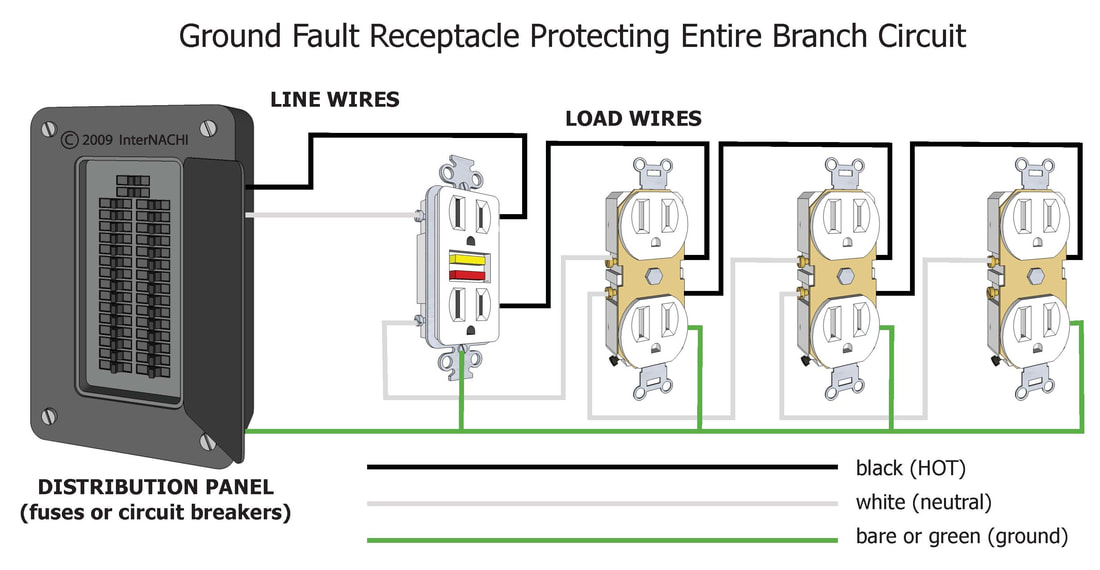Ground Fault Circuit Interrupters (GFCI)
WHAT IS A GFCI?
A ground fault circuit interrupter, called a GFCI or GFI, is an inexpensive electrical device that can either be installed in your electrical system or built into a power cord to protect you from severe electrical shocks. GFCIs have played a key role in reducing electrocutions.
If the GFCI's internal current transformer senses more than a 4-5 milliamp loss, it instantly shuts down the outlet and any outlets it feeds to prevent accidental electrocution. Most often, when a GFCI “trips” it is the result of a faulty appliance plugged into the outlet or an outlet down circuit.
Before calling an electrician, you may want to try this simple diagnosis: Unplug all appliances plugged into or down circuit from the GFCI, reset your GFCI by pushing the button in the center of the outlet and then plug the appliances back into the GFCI one at a time and turn them on to see if any of the appliances are causing the appliance to “trip”. If you plug in your coffee maker and the GFCI immediately trips, it is likely you have a faulty appliance and the GFCI is operating as designed.
All man-made objects have a lifespan and eventually wear out. It is recommended that all GFCI’s should be tested monthly to ensure they are operating correctly. Simply push the TEST button to turn power off to the circuit which should cause the RESET button to pop up. You will need to hit RESET to turn the GFCI back on. Do not assume that because an outlet is working that the GFCI protection is in effect. Newer GFCI outlets have an interlock to prevent the outlet from working if the GFCI protection fails however older GFCI outlets do not have this built-in failsafe.
GFCI outlets should be installed in any area where moisture can be potentially present, examples include kitchen countertop outlets, bathroom outlets, all exterior outlets and garages. Your electrician may suggest additional areas where GFCI protection is recommended or required by the National Electrical Code.
A ground fault circuit interrupter, called a GFCI or GFI, is an inexpensive electrical device that can either be installed in your electrical system or built into a power cord to protect you from severe electrical shocks. GFCIs have played a key role in reducing electrocutions.
If the GFCI's internal current transformer senses more than a 4-5 milliamp loss, it instantly shuts down the outlet and any outlets it feeds to prevent accidental electrocution. Most often, when a GFCI “trips” it is the result of a faulty appliance plugged into the outlet or an outlet down circuit.
Before calling an electrician, you may want to try this simple diagnosis: Unplug all appliances plugged into or down circuit from the GFCI, reset your GFCI by pushing the button in the center of the outlet and then plug the appliances back into the GFCI one at a time and turn them on to see if any of the appliances are causing the appliance to “trip”. If you plug in your coffee maker and the GFCI immediately trips, it is likely you have a faulty appliance and the GFCI is operating as designed.
All man-made objects have a lifespan and eventually wear out. It is recommended that all GFCI’s should be tested monthly to ensure they are operating correctly. Simply push the TEST button to turn power off to the circuit which should cause the RESET button to pop up. You will need to hit RESET to turn the GFCI back on. Do not assume that because an outlet is working that the GFCI protection is in effect. Newer GFCI outlets have an interlock to prevent the outlet from working if the GFCI protection fails however older GFCI outlets do not have this built-in failsafe.
GFCI outlets should be installed in any area where moisture can be potentially present, examples include kitchen countertop outlets, bathroom outlets, all exterior outlets and garages. Your electrician may suggest additional areas where GFCI protection is recommended or required by the National Electrical Code.

The requirement for GFCI (Ground Fault Circuit Interrupter) protection for receptacle outlets was phased in over the years by the NEC (National Electrical Code), beginning with the 1971 edition. The NEC is updated with a new edition every three years and the locations required have been expanded or tweaked with almost every edition since then, and will continue to be updated.
But, while the year that the NEC added a new location requirement is easy to define, each local jurisdiction’s building codes don’t necessarily adopt the latest edition of the NEC immediately. This is typical with most issues in the building code no matter what area or section of the code is discussed. The example I give is that we use to smoke on airplanes and didn't have seat belts in cars a long time ago.
The state of Florida, for example, did not make the 2011 NEC effective until mid-2015. Other jurisdictions have sometimes waited even longer to adopt a newer NEC edition and, to complicate things further, they might make amendments that exclude parts of the newest requirements. So the year listed below indicating when the NEC first required GFCI-protection for a new receptacle location can be several years before your local building department adopted that edition of the code and began enforcing it.
Regardless what was enforced in your area and at what time Code is a "minimum standard". Personal safety is very personal matter, no matter the government enforcement. I would definitely install them in these locations, no matter when the structure was built.
But, while the year that the NEC added a new location requirement is easy to define, each local jurisdiction’s building codes don’t necessarily adopt the latest edition of the NEC immediately. This is typical with most issues in the building code no matter what area or section of the code is discussed. The example I give is that we use to smoke on airplanes and didn't have seat belts in cars a long time ago.
The state of Florida, for example, did not make the 2011 NEC effective until mid-2015. Other jurisdictions have sometimes waited even longer to adopt a newer NEC edition and, to complicate things further, they might make amendments that exclude parts of the newest requirements. So the year listed below indicating when the NEC first required GFCI-protection for a new receptacle location can be several years before your local building department adopted that edition of the code and began enforcing it.
- Bathrooms - First required in 1975 NEC.
- Crawl Spaces - Beginning with 1990 NEC
- Dishwasher - GFCI required with 2014 NEC. If a receptacle, must be accessible. Not yet adopted in some jurisdictions.
- Disposal - Required by 2020 NEC.
- Exterior - All outdoor receptacles in 1975 NEC. Amended to include only receptacles with readily accessible to the ground (defined as below 6’-8” above grade) with 1987 NEC, then returned to all outdoor receptacles in 1996 NEC.
- Garage - All garage receptacles readily accessible (defined as below 6’-8” above floor), with exception for receptacles for dedicated appliances not easily movable (such refrigerator, sprinkler control panel) in 1978 NEC. Expanded to include all garage receptacles in 2008 NEC.
- Kitchen - Required for counter receptacles within 6 feet of sink in 1987 NEC. Expanded to include all kitchen counter receptacles with 1996 NEC.
- Pool - All receptacles within 15-feet of pool edge in 1971 NEC, and no receptacles at all allowed within 10-feet of pool edge. Later expanded to all receptacles within 20-feet of pool in 1996 NEC. Minimum distance from pool reduced to 6-feet from pool edge in 2008.
- Spa Tub Indoor - 1987 NEC required GFCI for receptacles within 10-feet of tub, but no receptacles allowed within 5-feet. Changed to no receptacles within 6-feet at 2008 NEC.
- Spa Tub Outdoor - 1984 NEC requires within 10-feet of edge, but no receptacles within 5-feet.
- Unfinished Basements - Required beginning with 1990 NEC.
- Wet Bar - Receptacles with 6-feet of wet bar sink on counter require GFCI protection beginning with 1993 NEC. Wet bar sink, with or without counter, 2005 Edition.
Regardless what was enforced in your area and at what time Code is a "minimum standard". Personal safety is very personal matter, no matter the government enforcement. I would definitely install them in these locations, no matter when the structure was built.
